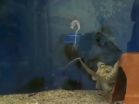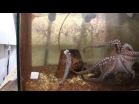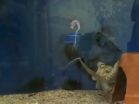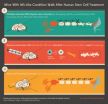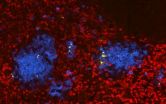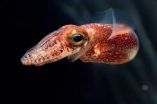(Press-News.org) VIDEO:
An octopus is treating its own freshly amputated arm in a strange and exploratory manner that is not commonly seen with respect to food items. Note the 'startle' response of...
Click here for more information.
An octopus's arms are covered in hundreds of suckers that will stick to just about anything, with one important exception. Those suckers generally won't grab onto the octopus itself; otherwise, the impressively flexible animals would quickly find themselves all tangled up.
Now, researchers from the Hebrew University of Jerusalem report in the Cell Press publication Current Biology on May 15 that they have discovered how octopuses manage this feat, even as the octopuses' brains are unaware of what their arms are doing. A chemical produced by octopus skin temporarily prevents their suckers from sucking.
"We were surprised that nobody before us had noticed this very robust and easy-to-detect phenomena," says Guy Levy, who carried out the research with co-first author Nir Nesher. "We were entirely surprised by the brilliant and simple solution of the octopus to this potentially very complicated problem."
Binyamin Hochner and his colleagues had been working with octopuses for many years, focusing especially on their flexible arms and body motor control. There is a very good reason that octopuses don't know where their arms are exactly, in the same way that people or other animals do.
"Our motor control system is based on a rather fixed representation of the motor and sensory systems in the brain in a formant of maps that have body part coordinates," Hochner explains.
That works for us because our rigid skeletons limit the number of possibilities. "It is hard to envisage similar mechanisms to function in the octopus brain because its very long and flexible arms have an infinite number of degrees of freedom," Hochner continues. "Therefore, using such maps would have been tremendously difficult for the octopus, and maybe even impossible."
VIDEO:
An octopus is reaching for a freshly amputated arm of another conspecific octopus and pulls it. Since the amputated arm is still alive, it holds the glass firmly, and the...
Click here for more information.
Indeed, experiments have supported the notion that octopuses lack accurate knowledge about the position of their arms. And that raised an intriguing question: How, then, do octopuses avoid tying themselves up in knots?
To answer that question, the researchers observed the behavior of amputated octopus arms, which remain very active for an hour after separation. Those observations showed that the arms never grabbed octopus skin, though they would grab a skinned octopus arm. The octopus arms didn't grab Petri dishes covered with octopus skin, either, and they attached to dishes covered with octopus skin extract with much less force than they otherwise would.
"The results so far show, and for the first time, that the skin of the octopus prevents octopus arms from attaching to each other or to themselves in a reflexive manner," the researchers write. "The drastic reduction in the response to the skin crude extract suggests that a specific chemical signal in the skin mediates the inhibition of sucker grabbing."
In contrast to the behavior of the amputated arms, live octopuses can override that automatic mechanism when it is convenient. Living octopuses will sometimes grab an amputated arm, and they appear to be more likely to do so when that arm was not formerly their own.
Hochner and his colleagues haven't yet identified the active agent in the animals' self-avoidance behavior, but they say it is yet another demonstration of octopus intelligence. The self-avoidance strategy might even find its way into bioinspired robot design.
"Soft robots have advantages [in] that they can reshape their body," Nesher says. "This is especially advantageous in unfamiliar environments with many obstacles that can be bypassed only by flexible manipulators, such as the internal human body environment."
In fact, the researchers are sharing their findings with European Commission project STIFF-FLOP, aimed to develop a flexible surgical manipulator in the shape of an octopus arm. "We hope and believe that this mechanism will find expression in such new classes of robots and their control systems," Hochner says.
INFORMATION:
Current Biology, Nesher et al.: "Self-recognition mechanism between skin and suckers prevents octopus arms from interfering with each other."
How octopuses don't tie themselves in knots
2014-05-15
ELSE PRESS RELEASES FROM THIS DATE:
First test of pluripotent stem cell therapy in monkeys is a success
2014-05-15
Researchers have shown for the first time in an animal that is more closely related to humans that it is possible to make new bone from stem-cell-like induced pluripotent stem cells (iPSCs) made from an individual animal's own skin cells. The study in monkeys reported in the Cell Press journal Cell Reports on May 15th also shows that there is some risk that those iPSCs could seed tumors, but that unfortunate outcome appears to be less likely than studies in immune-compromised mice would suggest.
"We have been able to design an animal model for testing of pluripotent ...
Mice with MS-like condition walk again after human stem cell treatment
2014-05-15
(SALT LAKE CITY) - Mice severely disabled by a condition similar to multiple sclerosis (MS) were able to walk less than two weeks following treatment with human neural stem cells. The finding, which uncovers potential new avenues for treating MS, will be published online on May 15, 2014, in the journal Stem Cell Reports.
In striking contrast to active, healthy mice, those with an MS-like condition must be fed by hand because they cannot stand long enough to eat and drink on their own. When scientists transplanted human neural stem cells into the MS mice, they expected ...
Not just a pretty face, although that helps female politicians on election day
2014-05-15
Female politicians' success can be predicted by their facial features, especially in conservative states where women with more feminine faces tend to do better at the ballot box, a Dartmouth College-led study finds.
The results don't mean a supermodel will win the White House, but they do suggest women's electoral success requires a delicate balance between voters' perception of traditional femininity and political competence. The study appears in the journal Social Psychological and Personality Science. A PDF of the study is available on request. Here is a video animation ...
Stem cell therapy shows promise for MS in mouse model
2014-05-15
LA JOLLA, CA—May 15, 2014—Mice crippled by an autoimmune disease similar to multiple sclerosis (MS) regained the ability to walk and run after a team of researchers led by scientists at The Scripps Research Institute (TSRI), University of Utah and University of California (UC), Irvine implanted human stem cells into their injured spinal cords.
Remarkably, the mice recovered even after their bodies rejected the human stem cells. "When we implanted the human cells into mice that were paralyzed, they got up and started walking a couple of weeks later, and they completely ...
Genetic tracking identifies cancer stem cells in human patients
2014-05-15
The gene mutations driving cancer have been tracked for the first time in patients back to a distinct set of cells at the root of cancer – cancer stem cells.
The international research team, led by scientists at the University of Oxford and the Karolinska Institutet in Sweden, studied a group of patients with myelodysplastic syndromes – a malignant blood condition which frequently develops into acute myeloid leukaemia.
The researchers say their findings, reported in the journal Cancer Cell, offer conclusive evidence for the existence of cancer stem cells.
The concept ...
Combination therapy a potential strategy for treating Niemann Pick disease
2014-05-15
CAMBRIDGE, Mass. (May 15, 2014) – By studying nerve and liver cells grown from patient-derived induced pluripotent stem cells (iPSCs), Whitehead Institute researchers have identified a potential dual-pronged approach to treating Niemann-Pick type C (NPC) disease, a rare but devastating genetic disorder.
According to the National Institutes of Health (NIH), approximately 1 in 150,000 children born are afflicted with NPC, the most common variant of Niemann-Pick. Children with NPC experience abnormal accumulation of cholesterol in their liver and nerve cells, leading to ...
'Bystander' chronic infections thwart development of immune cell memory
2014-05-15
PHILADELPHIA – Studies of vaccine programs in the developing world have revealed that individuals with chronic infections such as malaria and hepatitis tend to be less likely to develop the fullest possible immunity benefits from vaccines for unrelated illnesses. The underlying mechanisms for that impairment, however, are unclear, and distinguishing these so-called "bystander" effects on priming the immune system to fight future assaults versus development of immunological memory has been challenging.
A team from the Perelman School of Medicine at the University of Pennsylvania ...
E-cigarette awareness goes up, as (apparently) so does skepticism
2014-05-15
PHILADELPHIA (May 15, 2014) – Americans are unquestionably more aware of e-cigarettes, those vapor-emitting alternatives to tobacco cigarettes, according to a national survey. Yet, at the same time, the belief that e-cigarettes are safer than traditional smokes may be starting to diminish.
A national survey of 3,630 adults found that 77 percent of the respondents have heard of e-cigarettes; that's way up from 16 percent just five years ago. But the perception that e-cigarettes are actually less harmful than tobacco cigarettes among current smokers decreased slightly, ...
Protein sharpens salmonella needle for attack
2014-05-15
A tiny nanoscale syringe is Salmonella's weapon. Using this, the pathogen injects its molecular agents into the host cells and manipulates them to its own advantage. A team of scientists at the Biozentrum of the University of Basel demonstrate in their current publication in Cell Reports that a much investigated protein, which plays a role in Salmonella metabolism, is required to activate these needles and makes the replication and spread of Salmonella throughout the whole body possible.
The summer months are the prime time for Salmonella infections. Such an infection ...
The color of blood: Pigment helps stage symbiosis in squid
2014-05-15
MADISON, Wis. – The small but charismatic Hawaiian bobtail squid is known for its predator-fooling light organ.
To survive, the nocturnal cephalopod depends on a symbiotic association with a luminescent bacterium that gives it the ability to mimic moonlight on the surface of the ocean and, in the fashion of a Klingon cloaking device, deceive barracuda and other fish that would happily make a meal of the small creature.
The relationship between the squid and the bacterium Vibrio fischeri is well chronicled, but writing in the current issue of the journal Proceedings ...
